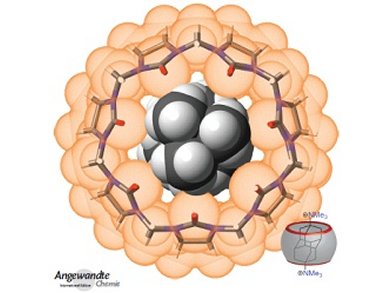This week, E. A. Theodorakis et al. review the chemistry and biology of neurotrophic natural products. How are such compounds synthesized and how do they induce neuronal growth? In a Minireview, S. Polarz et al. discuss hybrid surfactants with inorganic constituents. The Highlights deal with convergent synthesis planning of a complex alkaloid (X.-Y. Liu and D. Y.-K. Chen), the quest for ingenol (G. Appendino), and enantioselective wetting (G. Qing and T. Sun). In a set of Correspondence articles, H.-G. Korth, R. Rathore et al., and X. Wang et al. argue about persistent aniline radical cations, which were reported by the latter authors.
In the Communications section, L. Isaacs et al. present a highly stable cucurbit[7]uril–guest pair (see picture). B. Xing et al. succeeded in the NIR photoactivation of a platinum antitumor prodrug and simultaneous imaging. H. I Karunadasa et al. demonstrate reversible and irreversible chemisorption in nonporous–crystalline hybrids and C. A. Reed at al. report a superacidic fluorinated carborane that is capable of protonating alkanes at room temperature. M. Schnell et al. describe how to identify enantiomers in mixtures of chiral molecules with broadband microwave spectroscopy.

